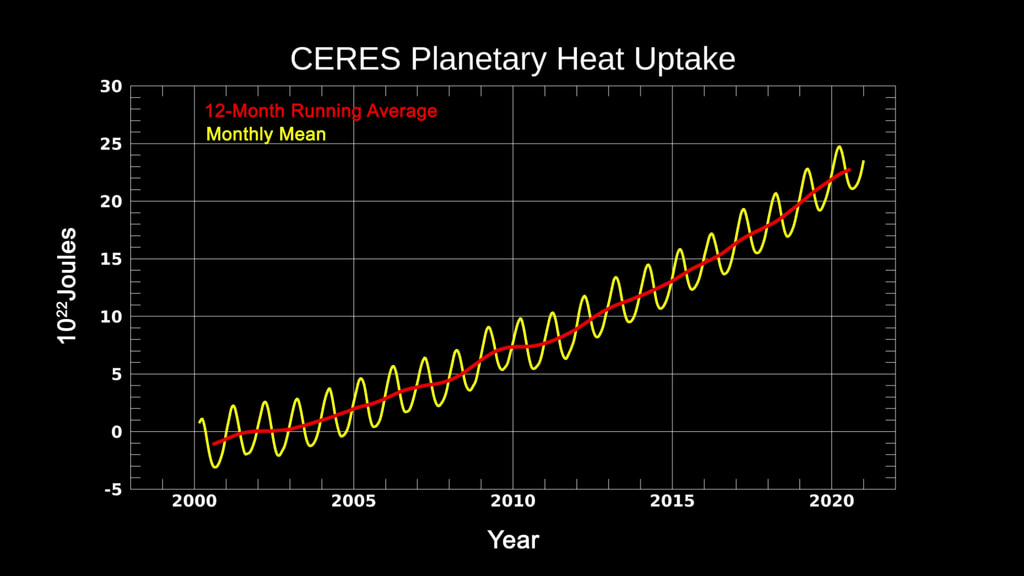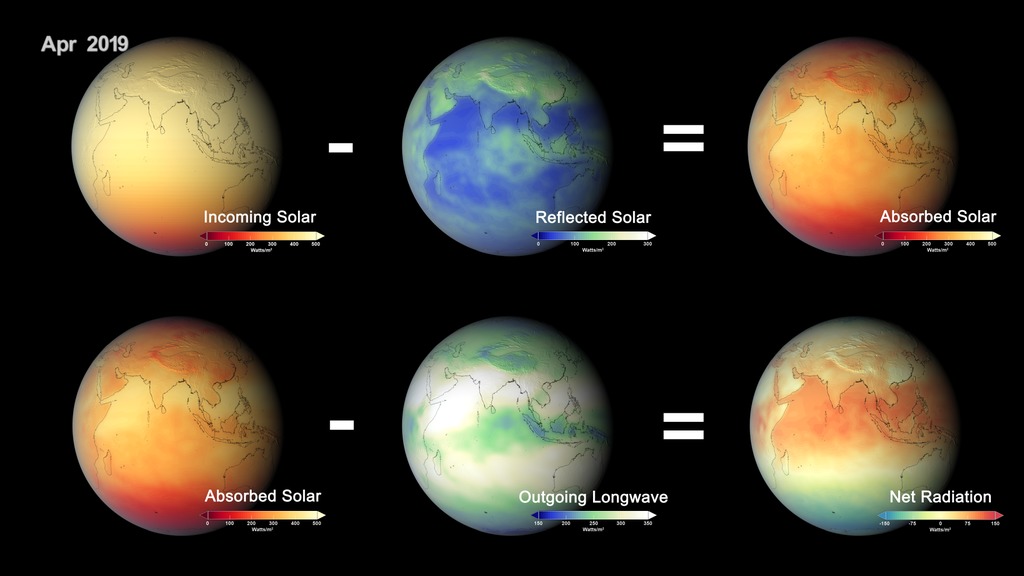A newer version of this visualization is available.
CERES Radiation Balance
The Clouds and the Earth’s Energy Radiant System (CERES) instrument is a key component of NASA’s Earth Observing System, with six active CERES instruments on satellites orbiting Earth and taking data.
For Earth’s temperature to be stable over long periods of time, absorbed solar and emitted thermal radiation must be equal. Increases in greenhouse gases, like carbon dioxide and methane, trap emitted thermal radiation from the surface and reduce how much is lost to space, resulting in a net surplus of energy into the Earth system. Most of the extra energy ends up being stored as heat in the ocean and the remainder warms the atmosphere and land, and melts snow and ice. As a consequence, global mean surface temperature increases and sea levels rise.
Much like a pulse or heartbeat, CERES monitors reflected solar and emitted thermal infrared radiation, which together with solar irradiance measurements is one of Earth’s ‘vital signs.’ Better understanding Earth’s energy balance enables us to be informed and adapt to a changing world.
Incoming solar radiation is measured from total solar irradiance instruments while CERES observes reflected solar and emitted thermal infrared radiation. The difference between incoming and reflected solar radiation is absorbed solar radiation. Red indicates energy being added while blue indicates a loss (reflected or emitted) of energy.
A plotted view of global mean surface temperature anomaly, or deviation from the long-term mean, since 1985.
A plotted view of planetary heat uptake since the beginning of the CERES data record showing an oscillating, monthly mean (yellow) and twelve-month running average (red line). These data show how much energy is added (absorbed) by Earth during the CERES period.
Credits
Please give credit for this item to:
NASA's Scientific Visualization Studio
-
Visualizer
- Trent L. Schindler (USRA)
-
Producers
- Jonathan Gleason (NASA/LaRC)
- Jefferson Beck (USRA)
- Ellen T. Gray (ADNET Systems, Inc.)
-
Writer
- Denise Lineberry (NASA/LaRC)
-
Scientist
- Norman Loeb (NASA/LRC)
Release date
This page was originally published on Friday, February 21, 2020.
This page was last updated on Monday, January 6, 2025 at 12:16 AM EST.
Datasets used
-
[Terra: CERES]
ID: 114The CERES instrument aboard many Earth-orbiting satellites records the flow of reflected Solar radiation and reprocessed longwave radiation in the Earth's radiation budget.
See all pages that use this dataset -
Incoming Solar Radiation [Aqua: CERES]
ID: 242Data from SORCE for the flux magnitude at the Earth's orbit, coupled with solar incidence angles based on CERES measurement locations and times
See all pages that use this dataset -
Outgoing Longwave Radiation [Terra: CERES]
ID: 485 -
Reflected Solar Radiation [Terra: CERES]
ID: 486 -
Shortwave Radiation [Terra: CERES]
ID: 487
Note: While we identify the data sets used on this page, we do not store any further details, nor the data sets themselves on our site.


